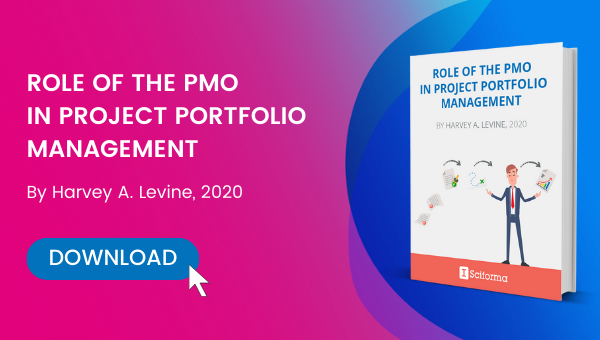The goal of the project portfolio management (PPM) discipline is to maximize the delivery of business value through the definition and implementation of carefully thought-out processes to optimize the selection and execution of projects. To support that effort, PMOs and PPM professionals usually rely on time-tested tools and methodological frameworks — including the portfolio roadmap (or strategic roadmap). A portfolio roadmap is basically a graphical visualization of the portfolio, which provides a high-level overview of the organization’s projects or products and helps to track value delivery and to improve strategic performance. This article will help you understand what a portfolio roadmap is and how it works, then explore the various use cases and benefits of portfolio roadmaps for project and product organizations.
What is a Portfolio Roadmap?
A portfolio roadmap is an overview of the portfolio depicted on a timeline. This way, it provides a big picture view of what is in the portfolio and of when the various initiatives are expected to start and to be completed. The portfolio roadmap will give the Project Management Office, portfolio managers or other key decision makers an at-a-glance understanding of the make-up and health of a portfolio. With the help of dedicated digital tools, one can also manipulate and filter the data to provide granular insights into the portfolio.
Benefits of a project portfolio roadmap
The graphical representation of your strategy shows effort across projects and provides the macro-level clarity that senior leadership needs in order to track the delivery of project value.
Roadmaps for strategic planning
Having a solid portfolio roadmap is key for successful project portfolio planning, as it offers much-needed visibility into project completion dates. Whenever too many projects finish at the same time, the organization’s resources risk overwhelm and an inability to absorb the impact. With the help of a proper roadmap, decision makers are able to sequence projects so as to prevent such bottlenecks.
Roadmaps for strategic management
Portfolio roadmaps also enable managers to track project progress against the organization’s goals and objectives. The managers can quickly see and easily understand which of the active projects support which strategic goal in order to get a sense of the portfolio’s strategic performance. Thanks to this clarity, they can make the required adjustments in a timely manner, ultimately ensuring that the projects and programs in the portfolio deliver the expected organizational benefits and value.
Roadmaps for work & tactical management
Beyond its use for strategic purposes, a portfolio roadmap is a critical tool to communicate directions and performance across the organization. A well-designed portfolio roadmap is shareable and understandable to all. It can, for example, be used in status review meetings to make tactical decisions based on a solid overview of the milestone status of projects. Or it can help project managers see and manage interdependencies and conflicts across initiatives.
Application of roadmaps to product portfolios
Portfolio roadmaps are particularly prevalent in product-oriented companies, as they are really suited to support the product development challenges.
What is a product?
A product is a physical (e.g. a piece of furniture) or intangible (e.g. a piece of software or an investment product) item that follows a “natural” lifecycle, from idea to concept to build to use to retirement. While a project is an endeavor to achieve a pre-defined outcome with a clear end date, a product may be used, supported, or even enhanced beyond the life of a project. Product management continues until the product reaches the end of its life.
- Make sure you focus on building the right products — the ones that will create the most value for your organization;
- Stop making ineffective products;
- Help you deliver the right product features at the right time, prioritizing the highest-yield products when you have to make trade-off decisions because of conflicts or interdependencies across the development cycles of different products;
- Ensure that potential end users and/or customers actually know and use the product.
Managing portfolios of products
Product portfolios are dynamic in nature. They encompass products that are at different stages of the development cycle. Also, portfolios are constantly growing with new product propositions. In other cases, products fail and drop from the portfolio. This means that product portfolio managers also need to embrace a dynamic approach. A product-oriented organization just can’t afford to waste its valuable resources by investing them in products that won’t deliver optimal value. Hence the importance of the product portfolio roadmap, which will provide the high-level visibility that the company needs to ensure consistent focus on the right issues and on the right product and at the right time.
Benefits of a product portfolio roadmap
The product portfolio roadmap materializes the links across products, product lines, and divisions in a way that makes the interconnections instantly easy to grasp. By connecting the objectives and the status of product lines and products, it helps ensure that the strategy for each product is consistent with the product-line level strategy.
The consolidated view that a roadmap provides helps decision-makers to ensure that their resources are consistently utilized to develop the right products and to build the right product features. Whereas organizations that do without proper product portfolio roadmaps might end up wasting energy on work that doesn’t support the overarching organizational goals. Besides, a robust roadmap will help fine-tune the overall direction of the portfolio: having a big picture view makes it easier for portfolio managers to spot gaps in strategy or to detect new opportunities to support the objectives they have set for their portfolio of products.
So, ready to add clarity to the management of your project and product portfolios?
For more insights on product development and management we suggest reading:
- How PPM Solves the Digitalization Conundrum for Industrial Product Development
- Late in Your New Product Development? Achieve On-Time Delivery with CCPM
- Aubert & Duval: Improving the Management of Product Development Cycles Starting with a Hands-on PMO







Benoît Boitard
Benoît has multiple professional experiences, working in particular as a digital strategy consultant, both in emerging start-ups and in large companies. These diverse experiences have imbued him with a global vision of project management in traditional and agile working environments.